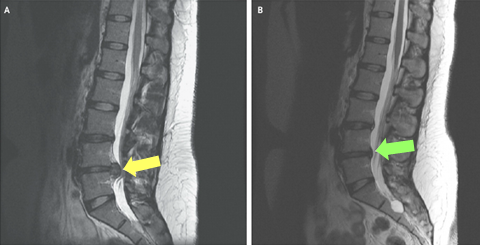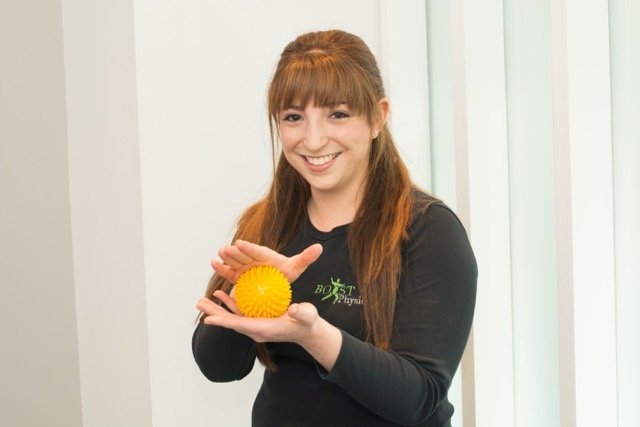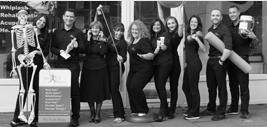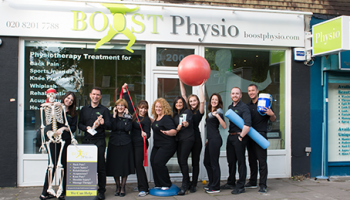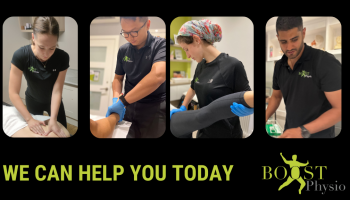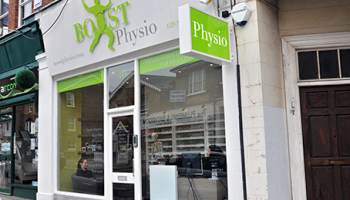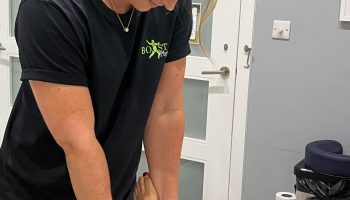What is a slipped disc?
The above scan belongs to a 29 year old woman who presented with new-onset pain and tingling in her right leg. The patient had a steroid injection, as well as a course of physiotherapy including soft tissue work, stretches and core strengthening. Within five months, her disc herniation had resolved, the pain and paraesthesia had completely gone. (Hong, J & Ball, P (2016) N Engl J Med 2016; 374:1564)
Figure A: MRI at the time of injury; the yellow arrow shows a lumbar disc herniation and nerve root compression.
Figure B: MRI at 5 months post-injury; the green arrow shows the disc is no longer compressing the nerve or spinal cord (white/grey column next to the vertebrae), with complete resolution of the slipped disc.
What is a slipped disc?
The spine is made up of 24 vertebrae that are stacked on top of each other. Between each vertebra, there is a disc made of a soft gel-like material, which acts as a shock-absorber or cushion. Discs are vital to help your back maintain its flexibility and range of movement. A slipped disc is a very common cause of back pain, and although the name can sound quite dramatic , it can be reassuring to note that the disc doesn’t actually ‘slip’.
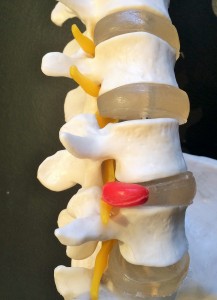
The red area shows the leaked disc fluid pressing on the spinal nerve (yellow), which can become inflamed, causing back pain and symptoms down the leg.
The outer-shell of the disc becomes damaged, so the gel inside protrudes, also known as a herniation. The discs lie directly adjacent to the spinal nerve root, therefore the leaked disc fluid puts a lot of pressure directly onto the nerve, causing back pain. When the nerve is compressed or irritated, the symptoms can spread down your legs causing numbness, tingling or weakness, called a radiculopathy. In many people, the sciatic nerve is affected, resulting in sciatica or neural symptoms down the leg. A slipped, herniated and bulged disc all essentially refer to the same type of injury. The variation in name can indicate how much of the disc fluid has leaked out, and whether or not it is compressing the nerve.
What causes a slipped disc?
With age, the discs lose some of their water content, making the disc less effective as a cushion, and more susceptible to injury following minimal strain or effort. Sometimes twisting or turning whilst lifting heavy objects can lead to a slipped disc, and people often don’t realise the extent of the injury at the time. The disc can put pressure on either the whole spinal cord or just a single nerve root. This means that you can have pain in the back where the herniation occurred, or other areas of the body that the affected nerve controls, for example the buttocks or feet.
How do you treat a slipped disc?
There are different options for management. In many cases, the pain will go away on its own, as the disc eventually shrinks away from the nerve, reducing the pressure on the nerve and relieving the pain on the affected nerve. This can take 6-8 weeks, or sometimes longer. Having a course of physiotherapy can usually help to relieve the pain, tightness and inflammation around the lumbar spine and associated muscles. Physiotherapy treatment often uses a combination of techniques to speed up healing, reduce pain, increase flexibility and strengthen the surrounding muscles. Core stability exercises or Pilates can help strengthen the back further and reduce the risk disc injuries recurring in the future. In more severe cases, an Orthopaedic Surgeon can be consulted who will usually do a scan to determine whether procedures such as steroid injections or surgery are required.
If you suspect a slipped disc, try to keep doing gentle movements and activities as much as possible. You make need to take pain killers and rest from the aggravating factors, but try to keep moving as much as you can to prevent further tightness and stiffening.
If you have a slipped disc, or would like to speak to us about treatment options, and physio for your back pain, please call us on 0208 201 7788 or book online.
Written by Naomi Sofer, Senior Physiotherapist
BOOST PHYSIO is a leading private physiotherapy practice with high street clinics across North and North West London. We have four branches in the following areas: Cricklewood NW2, Hampstead NW3, Hendon NW4 and East Finchley N2. We provide same-day physiotherapy treatment for sports injuries, neck and back pain. Appointments are available 8am to 9pm on weekdays, as well as Saturday and Sunday availability.


Mon-Thurs 8am-9pm
Fri 8am-3pm
Sat/Sun 9am-6pm

BOOST PHYSIO works with major insurance companies like: BUPA, AVIVA, WPA, CIGNA and Simplyhealth. We usually deal directly with your insurance company.



